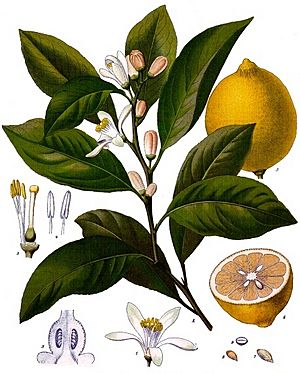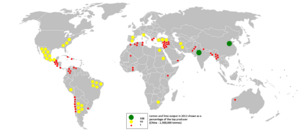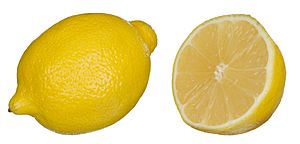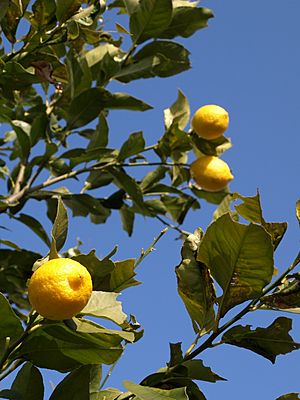Lemon facts for kids
Quick facts for kids Lemon |
|
|---|---|
 |
|
| Citrus limon | |
| Scientific classification | |
| Kingdom: | |
| (unranked): | |
| (unranked): | |
| (unranked): | |
| Order: | |
| Family: | |
| Genus: | |
| Species: |
C. limon
|
| Binomial name | |
| Citrus limon (L.) Burm.f.
|
|
 |
|
| Lemon and Lime output in 2012 | |
The lemon is a small tree that stays green all year, even in winter. It originally came from Asia. The word 'lemon' also refers to the tree's yellow, oval-shaped fruit. People use the fruit for cooking and many other things, especially for its sour juice.
No one knows exactly where lemons first grew. But many believe they came from areas like India, northern Myanmar, and China. The scientific name for the lemon is Citrus limon. It's a yellow citrus fruit, similar to an orange. Lemon juice is quite sour because it has about 5% citric acid. It has a low pH of 2 to 3. Lemon trees are usually small. They can grow up to about 6 meters tall.
Lemons taste very sour. Their juice, zest, and pulp are often used in cooking. They can add flavor to fish and other meats. Lemon is also used to flavor drinks, like lemonade or soft drinks.
Contents
History of Lemons
The exact origin of the lemon is a bit of a mystery. However, many think lemons first grew in Assam (a part of northeast India), northern Myanmar, or China. Scientists have studied the lemon's genes. They believe it is a mix of a bitter orange and a citron.
Lemons first arrived in Europe in southern Italy around 200 AD. This was during the time of Ancient Rome. But they were not grown much back then. Later, lemons were brought to Iran, then to Iraq and Egypt around 700 AD.
The first written record of lemons was in a 10th-century Arabic book about farming. They were also used as pretty plants in early Islamic gardens. Lemons spread widely across the Arab world and the Mediterranean region between 1000 and 1150 AD.
Growing lemons in Europe really started in Genoa, Italy, in the mid-1400s. Lemons came to the Americas in 1493. Christopher Columbus brought lemon seeds to Hispaniola on his trips. Spanish explorers helped spread lemon seeds throughout the New World. At first, lemons were mainly used as decorative plants and for medicine. In the 1800s, more lemon trees were planted in Florida and California.
In 1747, a doctor named James Lind did an important experiment. He gave lemon juice to sailors who had scurvy. This helped them get better. At that time, people did not know about vitamin C.
The word "lemon" likely comes from the Middle East. It comes from the Old French word limon. This came from the Italian limone, which came from the Arabic laymūn or līmūn. These words came from the Persian word līmūn, which means any citrus fruit.
Types of Lemons
There are many different types of lemons. Here are a few common ones:
- The 'Bonnie Brae' lemon is long and smooth. It has thin skin and no seeds. It grows mostly in San Diego County, USA.
- The 'Eureka' lemon grows all year round. This is the lemon you often see in supermarkets. It's also called 'Four Seasons' because it produces fruit and flowers throughout the year. You can even buy this type of plant for your home. There is also a 'Eureka' lemon with pink flesh and a green and yellow striped skin.
- The 'Femminello St. Teresa', or 'Sorrento', comes from Italy. The skin of this lemon has a lot of lemon oils. It is the type of lemon traditionally used to make a drink called limoncello.
- The 'Yen Ben' is a type of lemon grown in Australia and New Zealand.
Lemon Nutrients
Lemons are a great source of vitamin C. A 100-gram serving gives you 64% of the Daily Value for vitamin C. Other important nutrients are not found in large amounts.
Lemons also have many plant chemicals called phytochemicals. These include polyphenols, terpenes, and tannins. Lemon juice has a bit more citric acid than lime juice. It has almost twice as much citric acid as grapefruit juice. It has about five times the amount found in orange juice.
Cooking with Lemons
Lemon juice, rind, and peel are used in many different foods and drinks. The whole lemon can be used to make marmalade, lemon curd, and lemon liqueur. Thin slices of lemon and lemon rind are used to make food and drinks look nicer. The zest, which is the grated outer skin of the fruit, adds flavor to baked goods, puddings, rice, and other dishes.
Lemon Juice in Food
Lemon juice is used to make lemonade, soft drinks, and cocktails. It's also used to marinate fish. The acid in the juice helps remove the strong smell of fish. It also helps make meat more tender. In the United Kingdom, lemon juice is often put on pancakes, especially on Shrove Tuesday.
Lemon juice can also keep some foods from turning brown. When you slice apples, bananas, or avocados, they can turn brown quickly. A little lemon juice stops this from happening.
Using Lemon Peel
In Morocco, lemons are kept fresh in jars or barrels of salt. The salt soaks into the peel and rind, making them soft. This also helps them last for a very long time. These preserved lemons are used in many dishes. You can also find preserved lemons in Italian, Greek, and French cooking.
Lemon Leaves
The leaves of the lemon tree can be used to make a tea. They are also used when cooking meats and seafood.
Other Uses for Lemons
Lemons have many uses beyond food.
Industrial Uses
Lemons were once the main way to get citric acid for factories. But now, it's made using a process called fermentation.
Cleaning with Lemons
Lemon juice can be used for cleaning. If you cut a lemon in half and dip it in salt or baking powder, you can use it to make copper pots shiny. The acid cleans the tarnish, and the salt helps scrub. In the kitchen, lemon juice can remove bad smells, cut through grease, bleach stains, and clean surfaces. When mixed with baking soda, it can remove stains from plastic food containers.
The oil from a lemon's peel also has many uses. It's used as a wood cleaner and polish. It helps dissolve old wax, fingerprints, and dirt. Lemon oil and orange oil are also used as a safe way to get rid of insects.
Some people use a halved lemon to moisten their fingers. This helps them count large amounts of money, like bank tellers or cashiers.
Medicinal Uses
Lemon oil can be used in aromatherapy. This is a type of therapy that uses smells. The smell of lemon oil might help you feel more relaxed.
Other Fun Uses
You can do a cool science experiment with a lemon. If you put electrodes into a lemon, it can act like a battery and make electricity. It doesn't make much power, but several lemon batteries can power a small digital watch. This experiment also works with other fruits and vegetables.
Lemon juice can also be used as a simple invisible ink. You write with it, and then you can see the message when you heat the paper.
Images for kids
-
Variegated pink lemon
See also
 In Spanish: Limonero para niños
In Spanish: Limonero para niños











